Periglacial Lake Origin Influences the Likelihood of Lake Drainage in Northern Alaska
Abstract
:1. Introduction
2. Materials and Methods
2.1. Study Region
2.2. Image Processing
2.3. Surface Water Classification
2.4. Decadal Lake Drainage
2.5. Lake Origin Classification
3. Results
4. Discussion
5. Conclusions
Author Contributions
Funding
Institutional Review Board Statement
Informed Consent Statement
Data Availability Statement
Acknowledgments
Conflicts of Interest
Appendix A


References
- Verpoorter, C.; Kutser, T.; Seekell, D.A.; Tranvik, L.J. A Global Inventory of Lakes Based on High-Resolution Satellite Imagery. Geophys. Res. Lett. 2014. [Google Scholar] [CrossRef]
- Messager, M.L.; Lehner, B.; Grill, G.; Nedeva, I.; Schmitt, O. Estimating the Volume and Age of Water Stored in Global Lakes Using a Geo-Statistical Approach. Nat. Commun. 2016. [Google Scholar] [CrossRef]
- Arp, C.D.; Jones, B.M. Geography of Alaska Lake Districts: Identification, Description, and Analysis of Lake-Rich Regions of a Diverse and Dynamic State. U.S. Geological Survey. Scientific Investigations Report 2008-5215. 2009. Available online: https://pubs.usgs.gov/sir/2008/5215/ (accessed on 15 October 2020).
- Everdingen, R.O. Van Multi-Language Glossary of Permafrost and Related Ground-Ice Terms (Rev. Ed.). International Permafrost Association. 2005. Available online: http://globalcryospherewatch.org/reference/glossary_docs/Glossary_of_Permafrost_and_Ground-Ice_IPA_2005.pdf (accessed on 15 November 2020).
- Pullman, E.R.; Jorgenson, M.T.; Shur, Y. Thaw Settlement in Soils of the Arctic Coastal Plain, Alaska. Arctic Antarct. Alp. Res. 2007. [Google Scholar] [CrossRef] [Green Version]
- Jones, B.M.; Grosse, G.; Arp, C.D.; Jones, M.C.; Walter Anthony, K.M.; Romanovsky, V.E. Modern Thermokarst Lake Dynamics in the Continuous Permafrost Zone, Northern Seward Peninsula, Alaska. J. Geophys. Res. Biogeosci. 2011. [Google Scholar] [CrossRef]
- Shur, Y.L.; Kanevskiy, M.; Jorgenson, M.T.; Dillon, M.; Stephani, E.; Bray, M.; Fortier, D. Permafrost Degradation and Thaw Settlement under Lakes in Yedoma Environment. In Proceedings of the Tenth International Conference on Permafrost, Salekhard, Russia, 25–29 June 2012; pp. 383–388. [Google Scholar]
- Farquharson, L.M.; Mann, D.H.; Grosse, G.; Jones, B.M.; Romanovsky, V.E. Spatial Distribution of Thermokarst Terrain in Arctic Alaska. Geomorphology 2016. [Google Scholar] [CrossRef] [Green Version]
- Henriksen, M.; Mangerud, J.; Matiouchkov, A.; Paus, A.; Svendsen John Inge, I. Lake Stratigraphy Implies an 80 000 Yr Delayed Melting of Buried Dead Ice in Northern Russia. J. Quat. Sci. 2003. [Google Scholar] [CrossRef] [Green Version]
- Hinkel, K.M.; Sheng, Y.; Lenters, J.D.; Lyons, E.A.; Beck, R.A.; Eisner, W.R.; Wang, J. Thermokarst Lakes on the Arctic Coastal Plain of Alaska: Geomorphic Controls on Bathymetry. Permafr. Periglac. Process. 2012. [Google Scholar] [CrossRef]
- Grosse, G.; Jones, B.; Arp, C. Thermokarst Lakes, Drainage, and Drained Basins. In Treatise on Geomorphology; Shroder, J., Giardino, R., Harbor, J., Eds.; Academic Press: San Diego, CA, USA, 2013; Volume 8, pp. 325–353. ISBN 9780080885223. [Google Scholar] [CrossRef]
- Rouse, W.R.; Oswald, C.J.; Binyamin, J.; Spence, C.; Schertzer, W.M.; Blanken, P.D.; Bussières, N.; Duguay, C.R. The Role of Northern Lakes in a Regional Energy Balance. J. Hydrometeorol. 2005. [Google Scholar] [CrossRef]
- Wrona, F.J.; Prowse, T.D.; Reist, J.D.; Hobbie, J.E.; Lévesque, L.M.J.; Vincent, W.F. Climate Change Effects on Aquatic Biota, Ecosystem Structure and Function. AMBIO 2006, 35, 359–369. [Google Scholar] [CrossRef] [Green Version]
- Larsen, A.S.; O’Donnell, J.A.; Schmidt, J.H.; Kristenson, H.J.; Swanson, D.K. Physical and Chemical Characteristics of Lakes across Heterogeneous Landscapes in Arctic and Subarctic Alaska. J. Geophys. Res. Biogeosci. 2017. [Google Scholar] [CrossRef]
- Lewis, T.L.; Lindberg, M.S.; Schmutz, J.A.; Heglund, P.J.; Rover, J.; Koch, J.C.; Bertram, M.R. Pronounced Chemical Response of Subarctic Lakes to Climate-Driven Losses in Surface Area. Glob. Chang. Biol. 2015. [Google Scholar] [CrossRef] [PubMed]
- Deshpande, B.N.; Macintyre, S.; Matveev, A.; Vincent, W.F. Oxygen Dynamics in Permafrost Thaw Lakes: Anaerobic Bioreactors in the Canadian Subarctic. Limnol. Oceanogr. 2015. [Google Scholar] [CrossRef] [Green Version]
- Swanson, D.K. Thermokarst and Precipitation Drive Changes in the Area of Lakes and Ponds in the National Parks of Northwestern Alaska, 1984–2018. Arctic Antarct. Alp. Res. 2019. [Google Scholar] [CrossRef] [Green Version]
- Nitze, I.; Cooley, S.W.; R. Duguay, C.; Jones, M.B.; Grosse, G. The Catastrophic Thermokarst Lake Drainage Events of 2018 in Northwestern Alaska: Fast-Forward into the Future. Cryosphere 2020. [Google Scholar] [CrossRef]
- Nowacki, G.; Spencer, P.; Brock, T.; Fleming, M.; Jorgenson, M.T. Unified Ecoregions of Alaska and Neighboring Territories; US Geological Survey Open-File Report 02-297; US Geological Survey: Anchorage, Alaska, USA, 2001.
- Raynolds, M.K.; Walker, D.A.; Balser, A.; Bay, C.; Campbell, M.; Cherosov, M.M.; Daniëls, F.J.A.; Eidesen, P.B.; Ermokhina, K.A.; Frost, G.V.; et al. A Raster Version of the Circumpolar Arctic Vegetation Map (CAVM). Remote Sens. Environ. 2019. [Google Scholar] [CrossRef]
- Jorgenson, T.M.; Yoshikawa, K.; Kanevskiy, M.; Shur, Y.; Marchenko, S.; Jones, B. Permafrost Characteristics of Alaska. In Proceedings of the Ninth International Conference on Permafrost, Fairbanks, AK, USA, 29 June–3 July 2008; pp. 121–122. [Google Scholar]
- Jorgenson, M.T.; Shur, Y.; Kanevskiy, M.Z.; Grunblatt, J.; Michaelson, G.; Ping, C.-L. Permafrost Database Development, Characterization, and Mapping for Northern Alaska; United States Fish and Wildlife Service: Anchorage, AK, USA, 2014.
- Jorgenson, M.T.; Roth, J.E.; Emers, M.; Davis, W.A.; Schlentner, S.F.; Macander, M.J. Landcover Mapping for Bering Land Bridge National Preserve and Cape Krusenstern; Natural Resource Technical Report NPS/ARCN/NRTR—2004/001; National Park Service: Fort Collins, CO, USA, 2004.
- Carson, C.E.; Hussey, K.M. The Oriented Lakes of Arctic Alaska. J. Geol. 1962. [Google Scholar] [CrossRef]
- Pelletier, J.D. Formation of Oriented Thaw Lakes by Thaw Slumping. J. Geophys. Res. Earth Surf. 2005. [Google Scholar] [CrossRef] [Green Version]
- Schirrmeister, L.; Kunitsky, V.; Grosse, G.; Wetterich, S.; Meyer, H.; Schwamborn, G.; Babiy, O.; Derevyagin, A.; Siegert, C. Sedimentary Characteristics and Origin of the Late Pleistocene Ice Complex on North-East Siberian Arctic Coastal Lowlands and Islands—A Review. Quat. Int. 2011. [Google Scholar] [CrossRef] [Green Version]
- Pewe, T.L. US Government Printing Office. Quaternary Geology of Alaska; Geological Survey Professional Paper; US Government Printing Office: Washington, DC, USA, 1975.
- Fraser, T.A.; Burn, C.R. On the Nature and Origin of “Muck” Deposits in the Klondike Area, Yukon Territory. Can. J. Earth Sci. 1997. [Google Scholar] [CrossRef]
- Kauman, D.S.; Manley, W.F. Pleistocene Maximum and Late Wisconsinan Glacier Extents across Alaska, U.S.A. Dev. Quat. Sci. 2004. [Google Scholar] [CrossRef]
- Morgenstern, A.; Grosse, G.; Günther, F.; Fedorova, I.; Schirrmeister, L. Spatial Analyses of Thermokarst Lakes and Basins in Yedoma Landscapes of the Lena Delta. Cryosphere 2011. [Google Scholar] [CrossRef] [Green Version]
- Strauss, J.; Schirrmeister, L.; Wetterich, S.; Borchers, A.; Davydov, S.P. Grain-Size Properties and Organic-Carbon Stock of Yedoma Ice Complex Permafrost from the Kolyma Lowland, Northeastern Siberia. Global Biogeochem. Cycles 2012. [Google Scholar] [CrossRef] [Green Version]
- Kanevskiy, M.; Shur, Y.; Fortier, D.; Jorgenson, M.T.; Stephani, E. Cryostratigraphy of Late Pleistocene Syngenetic Permafrost (Yedoma) in Northern Alaska, Itkillik River Exposure. Quat. Res. 2011. [Google Scholar] [CrossRef]
- Begét, J.E.; Hopkins, D.M.; Charron, S.D. The Largest Known Maars on Earth, Seward Peninsula, Northwest Alaska. Arctic 1996. [Google Scholar] [CrossRef] [Green Version]
- Nitze, I.; Grosse, G.; Jones, B.M.; Romanovsky, V.E.; Boike, J. Remote Sensing Quantifies Widespread Abundance of Permafrost Region Disturbances across the Arctic and Subarctic. Nat. Commun. 2018. [Google Scholar] [CrossRef] [PubMed]
- Jones, B.M.; Arp, C.D.; Grosse, G.; Nitze, I.; Lara, M.J.; Whitman, M.S.; Farquharson, L.M.; Kanevskiy, M.; Parsekian, A.D.; Breen, A.L.; et al. Identifying Historical and Future Potential Lake Drainage Events on the Western Arctic Coastal Plain of Alaska. Permafr. Periglac. Process. 2020. [Google Scholar] [CrossRef] [PubMed] [Green Version]
- Marsh, P.; Russell, M.; Pohl, S.; Haywood, H.; Onclin, C. Changes in Thaw Lake Drainage in the Western Canadian Arctic from 1950 to 2000. Hydrol. Process. 2009, 23, 145–158. [Google Scholar] [CrossRef]
- Lara, M.J.; Chipman, M.L.; Hu, F.S. Automated Detection of Thermoerosion in Permafrost Ecosystems Using Temporally Dense Landsat Image Stacks. Remote Sens. Environ. 2019. [Google Scholar] [CrossRef]
- Lara, M.J.; Nitze, I.; Grosse, G.; Martin, P.; David McGuire, A. Reduced Arctic Tundra Productivity Linked with Landform and Climate Change Interactions. Sci. Rep. 2018. [Google Scholar] [CrossRef] [PubMed]
- Lara, M.J.; Nitze, I.; Grosse, G.; David McGuire, A. Data Descriptor: Tundra Landform and Vegetation Productivity Trend Maps for the Arctic Coastal Plain of Northern Alaska. Sci. Data 2018. [Google Scholar] [CrossRef]
- Billings, W.D.; Peterson, K.M. Vegetational Change and Ice-Wedge Polygons through the Thaw-Lake Cycle in Arctic Alaska. Arct. Alp. Res. 1980. [Google Scholar] [CrossRef]
- Chen, Y.; Hu, F.S.; Lara, M.J. Divergent Shrub-Cover Responses Driven by Climate, Wildfire, and Permafrost Interactions in Arctic Tundra Ecosystems. Glob. Chang. Biol. 2020. [Google Scholar] [CrossRef]
- Luedke, R.; Smith, R. Map Showing Distribution, Composition, and Age of Late Cenozoic Volcanic Centers in Alaska; United States Geological Survey Miscellaneous Investigations Series Map I 1091-F, Unpaged, 3 Sheets, Scale 1:1,000,000; United States Geological Survey: Reston, VA, USA, 1986. Available online: https://ngmdb.usgs.gov/Prodesc/proddesc_8948.htm (accessed on 5 July 2020).
- Strauss, J.; Laboor, S.; Fedorov, A.N.; Fortier, D.; Froese, D.; Fuchs, M.; Grosse, G.; Günther, F.; Harden, J.W.; Hugelius, G.; et al. Database of Ice-Rich Yedoma Permafrost (IRYP). PANGAEA-Data Publ. Earth Environ. Sci. 2016. [Google Scholar] [CrossRef]
- West, J.J.; Plug, L.J. Time-Dependent Morphology of Thaw Lakes and Taliks in Deep and Shallow Ground Ice. J. Geophys. Res. Earth Surf. 2008. [Google Scholar] [CrossRef] [Green Version]
- Roach, J.K.; Griffith, B.; Verbyla, D. Landscape Influences on Climate-Related Lake Shrinkage at High Latitudes. Glob. Chang. Biol. 2013. [Google Scholar] [CrossRef]
- Jones, B.M.; Arp, C.D. Observing a Catastrophic Thermokarst Lake Drainage in Northern Alaska. Permafr. Periglac. Process. 2015. [Google Scholar] [CrossRef]
- Smith, L.C. Disappearing Arctic Lakes. Science 2005. [Google Scholar] [CrossRef] [PubMed] [Green Version]
- Bergstedt, H.; Jones, B.; Farquharson, L.M.; Gaglioti, B.; Parsekian, A.; Kanevskiy, M.; Hinkel, K.; Rangel, R.; Ohara, N.; Breen, A.; et al. Towards Panarctic Mapping of Drained Lake Basins in Permafrost Regions. In Proceedings of the American Geophysical Union Poster, 1–7 December 2020; Available online: https://agu.confex.com/agu/fm20/meetingapp.cgi/Paper/669489 (accessed on 15 October 2020).
- Jorgenson, M.T.; Shur, Y. Evolution of Lakes and Basins in Northern Alaska and Discussion of the Thaw Lake Cycle. J. Geophys. Res. Earth Surf. 2007. [Google Scholar] [CrossRef]
- Yoshikawa, K.; Hinzman, L.D. Shrinking Thermokarst Ponds and Groundwater Dynamics in Discontinuous Permafrost near Council, Alaska. Permafr. Periglac. Process. 2003. [Google Scholar] [CrossRef]
- Jorgenson, M.T.; Marcot, B.G.; Swanson, D.K.; Jorgenson, J.C.; DeGange, A.R. Projected Changes in Diverse Ecosystems from Climate Warming and Biophysical Drivers in Northwest Alaska. Clim. Chang. 2015. [Google Scholar] [CrossRef] [Green Version]
- Kokelj, S.V.; Tunnicliffe, J.; Lacelle, D.; Lantz, T.C.; Chin, K.S.; Fraser, R. Increased Precipitation Drives Mega Slump Development and Destabilization of Ice-Rich Permafrost Terrain, Northwestern Canada. Glob. Planet. Chang. 2015. [Google Scholar] [CrossRef] [Green Version]
- Segal, R.A.; Lantz, T.C.; Kokelj, S.V. Acceleration of Thaw Slump Activity in Glaciated Landscapes of the Western Canadian Arctic. Environ. Res. Lett. 2016. [Google Scholar] [CrossRef]
- Lewkowicz, A.G.; Way, R.G. Extremes of Summer Climate Trigger Thousands of Thermokarst Landslides in a High Arctic Environment. Nat. Commun. 2019. [Google Scholar] [CrossRef] [PubMed] [Green Version]
- Walter Anthony, K.; Daanen, R.; Anthony, P.; Schneider Von Deimling, T.; Ping, C.L.; Chanton, J.P.; Grosse, G. Methane Emissions Proportional to Permafrost Carbon Thawed in Arctic Lakes since the 1950s. Nat. Geosci. 2016. [Google Scholar] [CrossRef]
- Walter, K.M.; Zimov, S.A.; Chanton, J.P.; Verbyla, D.; Chapin, F.S. Methane Bubbling from Siberian Thaw Lakes as a Positive Feedback to Climate Warming. Nature 2006. [Google Scholar] [CrossRef]
- Zimov, S.A.; Voropaev, Y.V.; Semiletov, I.P.; Davidov, S.P.; Prosiannikov, S.F.; Chapin, F.S.; Chapin, M.C.; Trumbore, S.; Tyler, S. North Siberian Lakes: A Methane Source Fueled by Pleistocene Carbon. Science 1997. [Google Scholar] [CrossRef] [Green Version]
- Wik, M.; Varner, R.K.; Anthony, K.W.; MacIntyre, S.; Bastviken, D. Climate-Sensitive Northern Lakes and Ponds Are Critical Components of Methane Release. Nat. Geosci. 2016, 9, 99–105. [Google Scholar] [CrossRef]
- Lara, M.J.; McGuire, A.D.; Euskirchen, E.S.; Genet, H.; Yi, S.; Rutter, R.; Iversen, C.; Sloan, V.; Wullschleger, S.D. Local-Scale Arctic Tundra Heterogeneity Affects Regional-Scale Carbon Dynamics. Nat. Commun. 2020. [Google Scholar] [CrossRef] [PubMed]
- Strauss, J.; Schirrmeister, L.; Grosse, G.; Fortier, D.; Hugelius, G.; Knoblauch, C.; Romanovsky, V.; Schädel, C.; Schneider von Deimling, T.; Schuur, E.A.G.; et al. Deep Yedoma Permafrost: A Synthesis of Depositional Characteristics and Carbon Vulnerability. Earth Sci. Rev. 2017, 172, 75–86. [Google Scholar] [CrossRef] [Green Version]

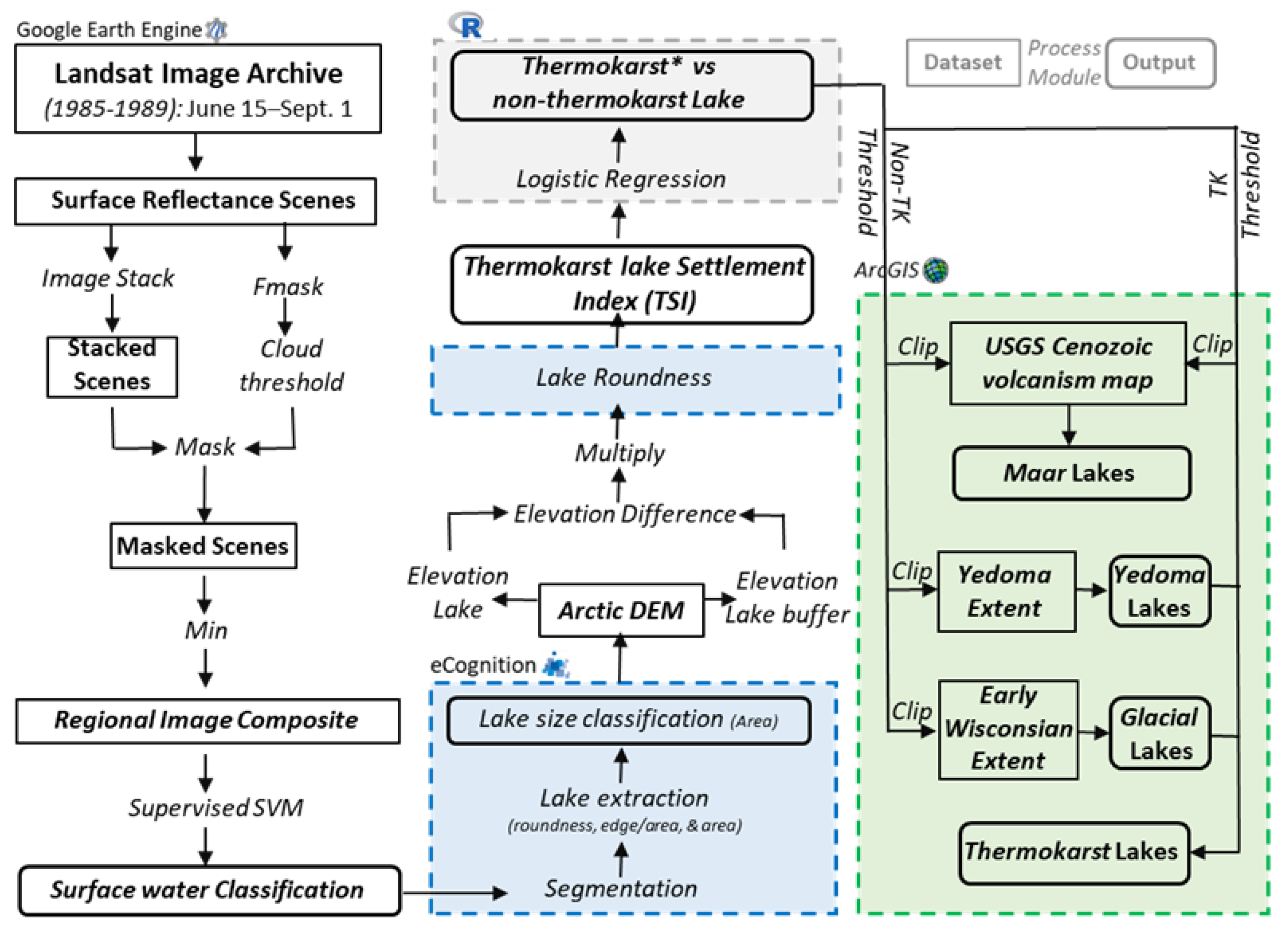
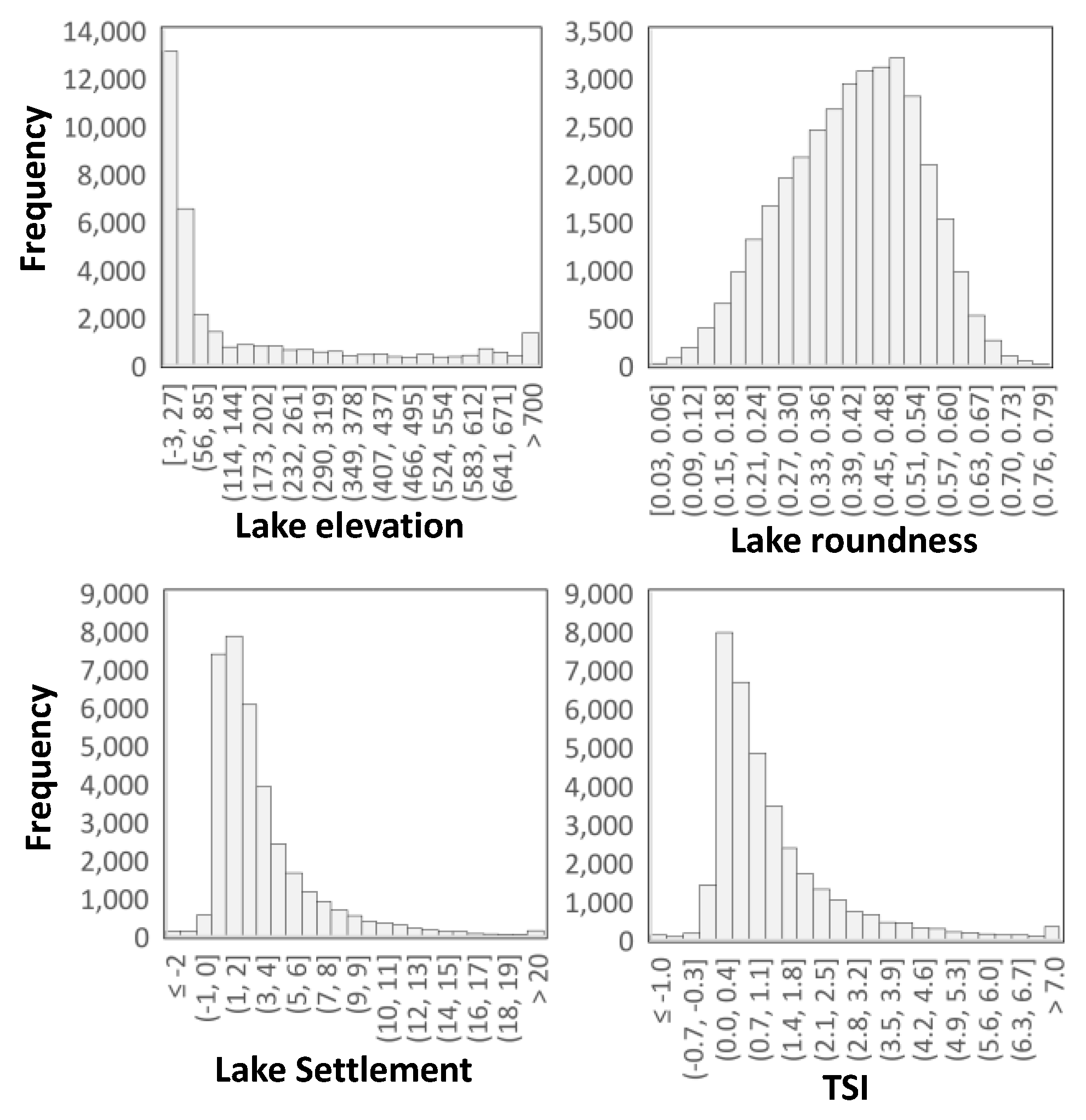
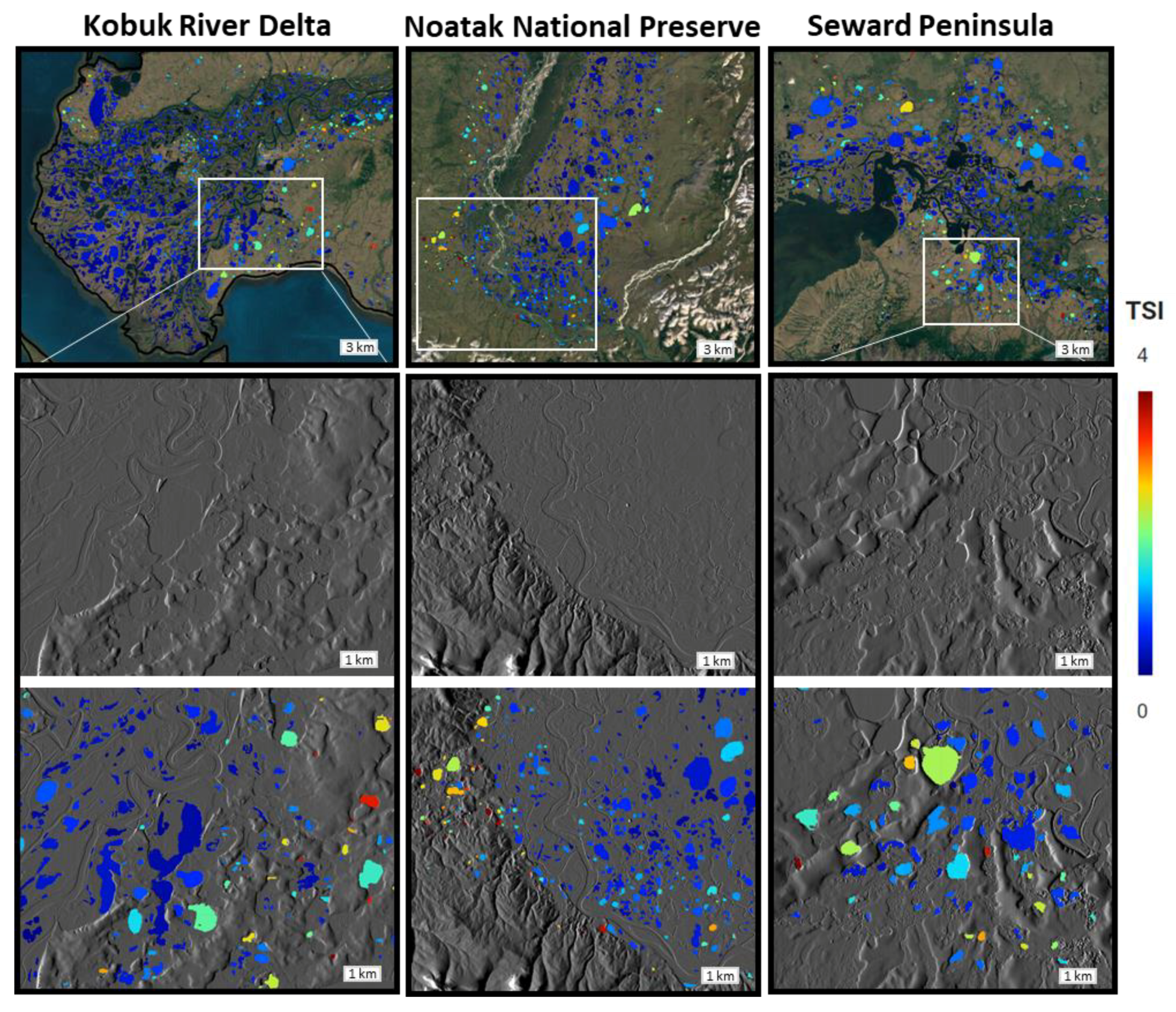
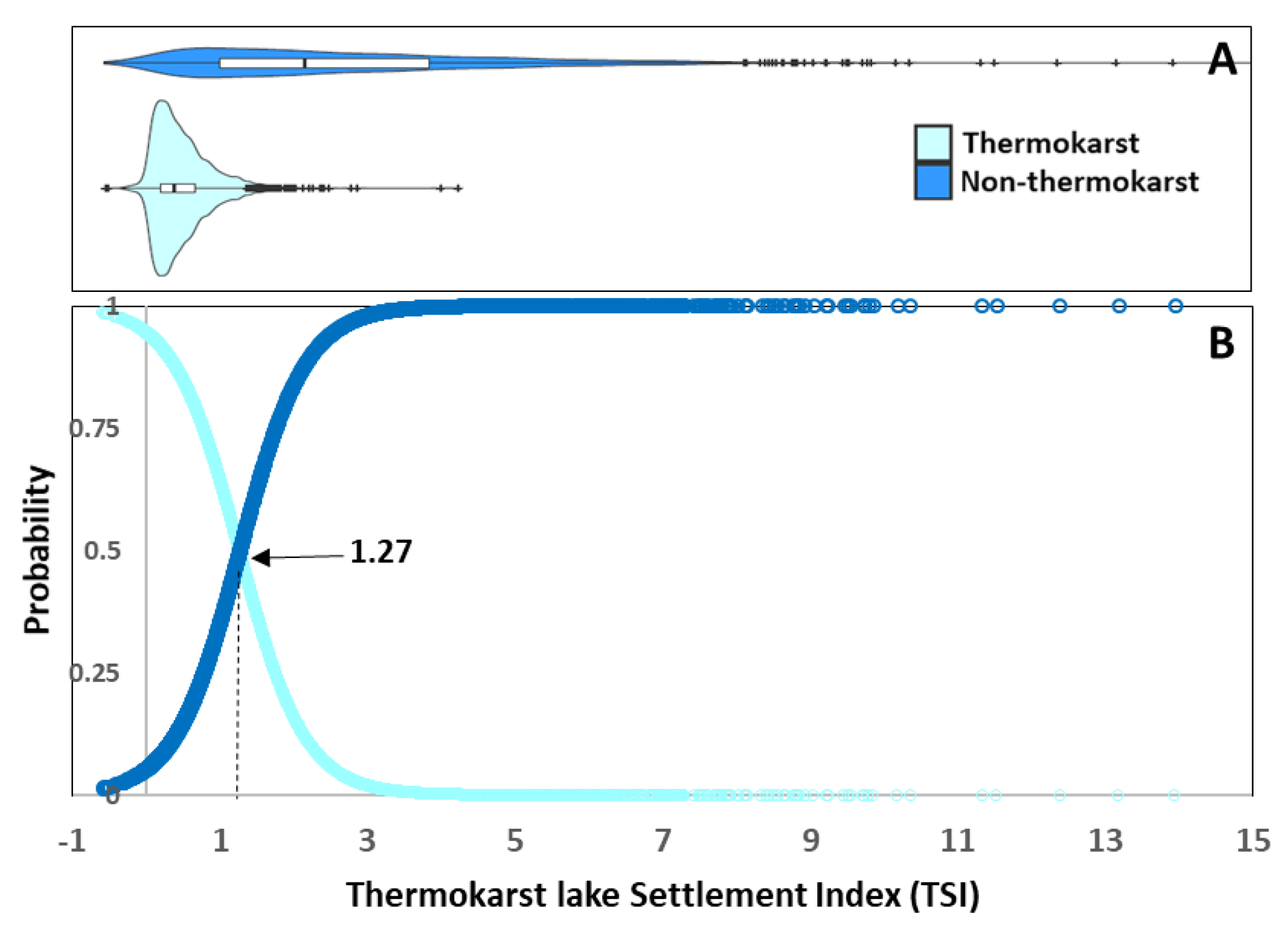
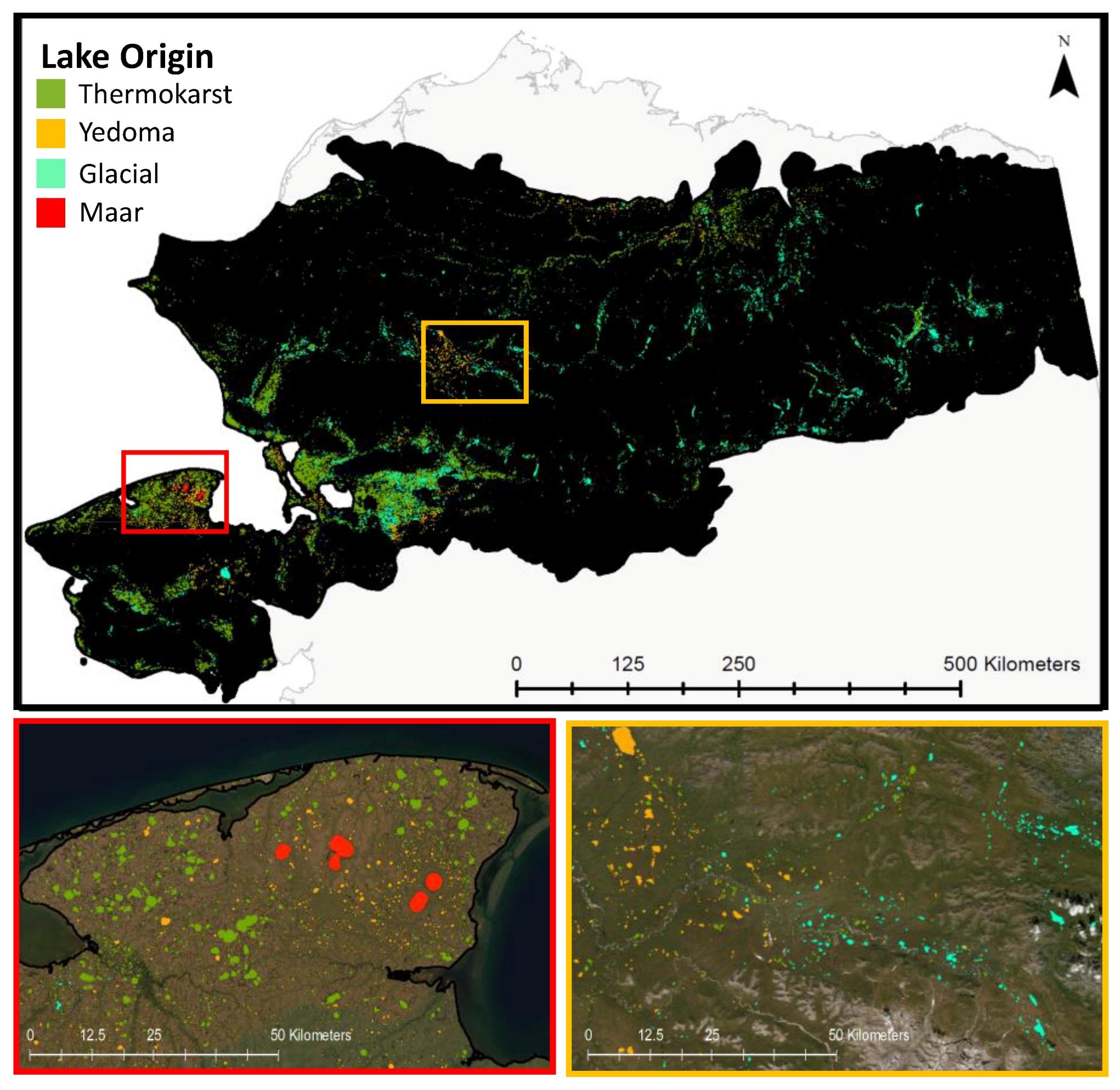
| Lake Origin | Description |
|---|---|
| Thermokarst | Thermokarst lakes (non-yedoma) form in closed depressions by the thaw and collapse of ice-rich permafrost or massive ground ice; widespread in low topographic relief permafrost terrain. |
| Yedoma | Yedoma thermokarst lakes form in extremely ice-rich organic rich silt (loess) soils, where sedimentation of fine material has been relatively continuous such as deltas, flood plains, and loess belts; commonly found in alluvial plains, hillslopes, and polygonal lowlands across Alaska. |
| Glacial | Glacial lakes form following the collapse of stagnant buried ice blocks deposited following glacial recession; found throughout the late Wisconsinan glacial extent in relatively ice-poor terrain. |
| Maar | Maar lakes form within a volcanic craters that develops when hot lava encroaches into the groundwater causing a violent phreatomagmatic eruption; found in the Seward Peninsula within ice-poor terrain. |
| Lake Origin | Lake Size Class | Sample Size | Lake Area (ha) | Lake Perimeter (m) | Shoreline Development Ratio β | Lake Roundness β | Lake Settlement (m) | Thermokarst Lake Settlement Index β | Proportion of Lakes to Completely Drain δ |
|---|---|---|---|---|---|---|---|---|---|
| Thermokarst | Large | 301 | 212.8 | 10,443.2 | 2.121 | 0.287 | 1.800 | 0.453 | 6.3% |
| Medium | 1695 | 38.3 | 4217.3 | 1.951 | 0.309 | 1.791 | 0.514 | 6.4% | |
| Small | 19,417 | 4.5 | 1167.4 | 1.647 | 0.402 | 1.345 | 0.506 | 12.7% | |
| All | 21,413 | 10.1 | 1539.2 | 1.678 | 0.393 | 1.387 | 0.506 | 12.1% | |
| Yedoma | Large | 24 | 262.8 | 8907.7 | 1.667 | 0.381 | 7.165 | 2.602 | 12.5% |
| Medium | 196 | 38.4 | 3393.7 | 1.581 | 0.421 | 6.998 | 2.879 | 7.7% | |
| Small | 2323 | 4.4 | 1023.0 | 1.480 | 0.475 | 6.127 | 2.832 | 9.6% | |
| All | 2543 | 9.4 | 1280.1 | 1.489 | 0.470 | 6.204 | 2.833 | 9.5% | |
| Glacial | Large | 102 | 399.1 | 12,177.0 | 1.913 | 0.311 | 11.674 | 3.117 | 4.9% |
| Medium | 532 | 36.8 | 3497.6 | 1.653 | 0.392 | 7.629 | 2.779 | 4.1% | |
| Small | 8096 | 4.3 | 1040.2 | 1.502 | 0.464 | 6.299 | 2.791 | 9.0% | |
| All | 8730 | 10.9 | 1320.1 | 1.516 | 0.458 | 6.443 | 2.794 | 8.7% | |
| Maar | Large | 4 | 1209.0 | 18,079.3 | 1.456 | 0.498 | 19.727 | 9.884 | 0.0% |
| All | 4 | 1209.0 | 18,079.3 | 1.456 | 0.498 | 19.727 | 9.884 | 0.0% | |
| Total | 32,690 | 10.4 | 1462.6 | 1.620 | 0.416 | 3.114 | 1.299 | 11.0% |
Publisher’s Note: MDPI stays neutral with regard to jurisdictional claims in published maps and institutional affiliations. |
© 2021 by the authors. Licensee MDPI, Basel, Switzerland. This article is an open access article distributed under the terms and conditions of the Creative Commons Attribution (CC BY) license (http://creativecommons.org/licenses/by/4.0/).
Share and Cite
Lara, M.J.; Chipman, M.L. Periglacial Lake Origin Influences the Likelihood of Lake Drainage in Northern Alaska. Remote Sens. 2021, 13, 852. https://doi.org/10.3390/rs13050852
Lara MJ, Chipman ML. Periglacial Lake Origin Influences the Likelihood of Lake Drainage in Northern Alaska. Remote Sensing. 2021; 13(5):852. https://doi.org/10.3390/rs13050852
Chicago/Turabian StyleLara, Mark Jason, and Melissa Lynn Chipman. 2021. "Periglacial Lake Origin Influences the Likelihood of Lake Drainage in Northern Alaska" Remote Sensing 13, no. 5: 852. https://doi.org/10.3390/rs13050852






